Mark Twain used to say that you should never get into a row with anyone who buys ink by the barrel. But last weekend The Irish Times, our national Paper of Record, ran a Weekend Review feature about the problematical relationship of Dun Laoghaire with its harbour, a two-article feature which concentrated largely on the town’s urban blight of shuttered shops and commercial dereliction at its centre, while giving only scant attention to the waterfront and the harbour, with their problems and potentials for development and better interaction with the town.
It all initially sounded well-meaning and timely, in view of the fact that the 17th September is the closing date for €200,000 worth of contracts – two of them – for tenders for surveys providing expert economic and strategic advice about how the blighted parts of the town might be revived, and how the harbour might be more usefully developed.
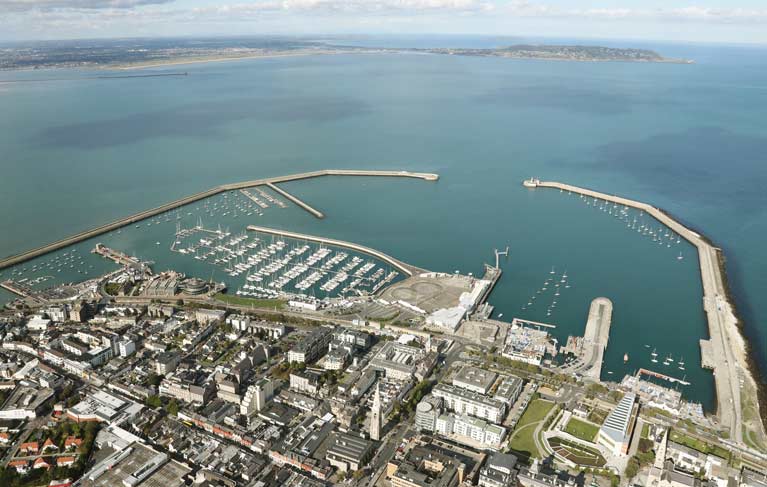 A town and its harbour – in Dun Laoghaire, inter-community attitudes are shaped by many other elements in addition to the fact that road and railway create a physical divide for part of the waterfront. Photo Barrow Coakley/Simon Coate
A town and its harbour – in Dun Laoghaire, inter-community attitudes are shaped by many other elements in addition to the fact that road and railway create a physical divide for part of the waterfront. Photo Barrow Coakley/Simon Coate
Dun Laoghaire Rathdown Council took over control of the harbour only as recently as late last year, so it will take time for an attitude of joined-up thinking regarding the relationship of town and harbour to develop properly. As it is, the very framing of these tenders shows that the attitude of seeing town and harbour as separate entities still persists, as one set of expert advice is sought for the regeneration of “Dun Laoghaire’s town centre adjacent to the harbour”, while the other is one is “seeking expert advice for the development of the harbour for the benefit of its citizens”.
But however they go about it, the situation is a matter of some urgency, as they’re immediately faced with a major problem. Since the Dun Laoghaire ferry port ceased functioning in 2015, the harbour has an increasingly significant deficit in its maintenance budget.
It’s a serious situation, involving everyone. In view of that, somebody has to say that The Irish Times feature was a travesty of what such an overview should be. While a succession of traders and politicians in the town were interviewed about its problems of urban blight, and the problems of its high-maintenance harbour, not one interview was conducted with anyone who is active in any way around the harbour, whether as a marine trader or sailor or boat or watersports enthusiast in any form whatsoever.
Yet it was a research mission and ensuing feature which seemed at first to merit serious attention. The articles - given considerable prominence - were by two of the paper’s most distinguished contributors: journalist Jennifer O’Connell and economist David McWilliams. It must have been given some thought. But even on ploughing through it a second time, we still couldn’t find any suggestion that either had talked to anyone other than local business people or politicians. There wasn’t so much as the tiniest cheep - neither from the Dun Laoghaire boating and sailing community nor from the businesses which specifically serve their needs - about what their hopes for harbour and waterfront development and relationships with the town might be.
David McWilliams now has skin in the game. As anyone who reads his usually stimulating columns will be aware, having for some time been a pillar of Dalkey intellectual society, he and his family have recently moved to a substantial waterfront house beside Dun Laoghaire harbour. So he must see some future in the place. And who knows, but maybe some time he might take an active interest in boats beyond seeing them as some sort of ornaments which help to remind him that he is in the desirable position of living beside the sea.
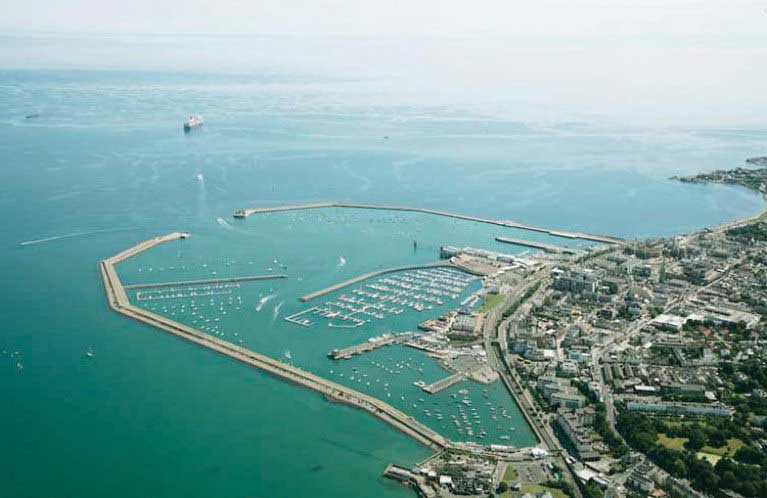 Summer in Dun Laoghaire – in such a setting, harmony between land and sea should come naturally. Photo Peter Barrow
Summer in Dun Laoghaire – in such a setting, harmony between land and sea should come naturally. Photo Peter Barrow
As for Jennifer O’Connell, she seems to live somewhere beyond The Pale, but in terms of working as an Irish Times columnist and reporter, she makes the Duracell Bunny look like a complete and utter layabout, with her lengthy article on Dun Laoghaire making our usual Sailing on Saturday long-form story look like a quick post-it message.
But even she – in her long and detailed piece – has managed to avoid the boat folk. Now admittedly in her sprint through a couple of those sadder Dun Laoghaire shopping streets that you find as you move inland from the increasingly chic waterfront, she did chat with Australian sailor Bruce Du Ve, who has settled in Dun Laoghaire, and some of you will know him. But it emerged that the reason for the interview is because Bruce is running an acupuncture clinic in Dun Laoghaire, and thus is seen as a representative local businessman.
The nearest he was allowed to talk about sailing was in making the point that when a breeze blows through Dun Laoghaire’s granite-hard streets, regardless of its suitability or otherwise for sailing such a breeze inevitably seems to carry an indecent amount of litter with it, and Bruce wonders why it is so difficult to clean the streets. Reasonable enough, perhaps. But what Bruce thinks about sailing in Dun Laoghaire is left as a matter for speculation.
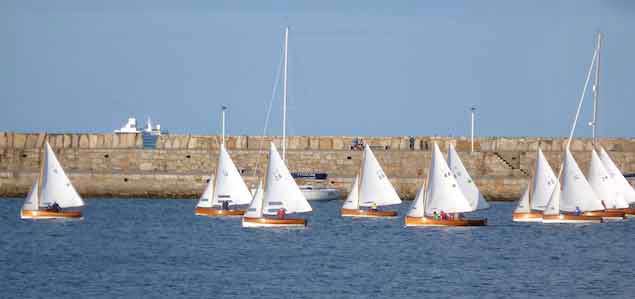 The Water Wags have been racing in Dun Laoghaire since 1887, with the present class dating to 1900. The magnificently-built 200-year-old granite harbour seems so much a part of the seascape and the land beside it that the locals tend to see it as a natural feature of Dublin Bay. Photo: W M Nixon
The Water Wags have been racing in Dun Laoghaire since 1887, with the present class dating to 1900. The magnificently-built 200-year-old granite harbour seems so much a part of the seascape and the land beside it that the locals tend to see it as a natural feature of Dublin Bay. Photo: W M Nixon
Maybe that’s a very subtle technique of High Journalism for keeping us interested. Whatever, we’ve been here before on the conundrum of the Dun Laoghaire and its harbour situation, and God knows, we’ll be here again. But its approaching wave of new attention thanks to that tendering date of just ten days hence brings it top of the bill right now.
Thus for journalists and others seriously hoping to find out how Dun Laoghaire is currently inter-acting positively with the sea and sailing and boating, a logical first stop would be a discussion with Kenneth Rumball of the Irish National Sailing and Powerboat School, which is located in a hyper-busy little building on the quayside in the somewhat hidden southwest corner of the Inner Harbour. Size-for-size since its establishment by Kenneth’s father Alistair in 1974, the INSS has done more to introduce complete newcomers to sailing and boating in Ireland than any other comparable organisation.
 Alistair Rumball (left) founder in 1974 of the Irish National Sailing School in Dun Laoghaire, with his wife Muriel and son Kenneth, current School Director. Photo: W M Nixon
Alistair Rumball (left) founder in 1974 of the Irish National Sailing School in Dun Laoghaire, with his wife Muriel and son Kenneth, current School Director. Photo: W M Nixon
The figures run into the tens of thousands and have included crews who have been taken right to the top for competition in both the Round Ireland and Fastnet Races, in both of which the INSS boat has won her class.
As for the school, while it is of course a private enterprise business extremely efficiently run, it is almost like a classic mutual society company in many ways, and within its setup is a proper sailing club, complete with committee and flag officers, such that those who start from scratch as beginner sailors with the INSS can go all the way to recognised sailing competition at local, national and international level, all under the INSS umbrella.
Thus the breadth and depth of experience at the INSS about what people new to sailing expect from Dun Laoghaire Harbour now and in the future is unrivalled. Yet did either of the journalists creating The Irish Times feature of a week ago contact Kenneth Rumball or one of his colleagues? No, they did not.
At a different level of interaction with the sailing community of Dun Laoghaire is the marine store of Viking Marine in Marine Road, plumb in the middle of the relatively new Pavilion Development. Viking Marine reflects the growing vitality and style of Dun Laoghaire’s classic waterfront as the years of the harbour being a ferryport recede into history.
Admittedly Dun Laoghaire ferryport was never a seriously unpleasant place like Dover, or the scruffily spread-out ferryport area that we find in Holyhead. But even so, the regular throughput of shiploads of cars and trucks was detrimental to the style and atmosphere of the waterfront, and now that the heavy trucks are no longer blighting the narrow roads, the area is being re-born.
 Work or play? Ian O’Meara of Viking Marine in Dun Laoghaire at his favourite sport off his favourite town. Photo Afloat.ie/David O’Brien
Work or play? Ian O’Meara of Viking Marine in Dun Laoghaire at his favourite sport off his favourite town. Photo Afloat.ie/David O’Brien
Consequently Viking Marine is at the very heart of what Dun Laoghaire’s future might be. But did The Irish Times make any contact whatever with Ian O’Meara, Managing Director of Viking Marine. No, they did not.
Yet with Ian O’Meara they would have found in one notably savvy person a very complete and thoughtful projection of how the relationship of Dun Laoghaire and its harbour could usefully be developed. Not only does he run one of the most successful shops in the town, but he’s an active sailor himself, very much part of the front-line sailing community - so much so, in fact, that he was a key crewmember on the winning boat in 2019’s biennial staging of the rugged Dun Laoghaire to Dingle Race.
But despite Ian O’Meara’s very special position in the centre of the marine leisure retail/customer dynamic in Dun Laoghaire, The Irish Times didn’t see fit to draw on his unique knowledge and experience. Nor did they chat with Paal Janson, manager of the extensive and award-winning Dun Laoghaire Marina.
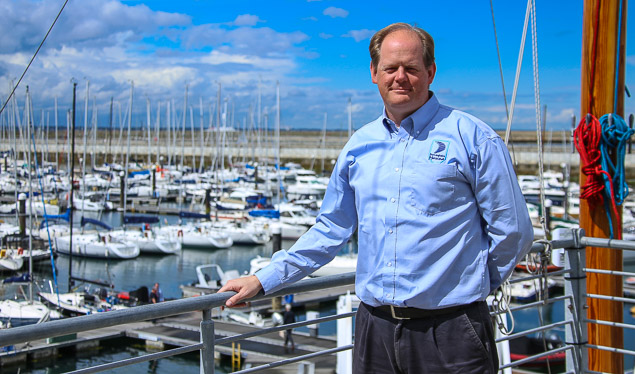 Paal Janson of Dun Laoghaire Marina. Photo: Afloat.ie/David O’Brien
Paal Janson of Dun Laoghaire Marina. Photo: Afloat.ie/David O’Brien
No contact seems to have been made either with any of the four waterfront yacht clubs, despite the fact that they make an exemplary job of utilizing and running their very limited spaces while providing the sailing and training programmes which give Dun Laoghaire Harbour its favourable international image, even if parts of the town behind it seeming to be unable to keep up with the new pace and style. And even Irish Sailing, the National Authority which is headquartered in Dun Laoghaire, seems to have been unaware that The Irish Times were in town on this research project.
So why has Dun Laoghaire town never really interacted comfortably in modern times with its massive 200 years old harbour, which is such a magnificent piece of granite construction that most folk think of it as a natural feature, whereas it is just about artificial as it can get – its brilliant use of granite simply deludes us.
It was never built to be a port. It was built as a harbour of shelter primarily to meet the needs of the ships of British imperial power. Thus there is a totally inadequate landward space to serve the needs of a port in the trading and commercial sense. And though the use of it as a ferryport worked fine in the great days of rail travel when Carlisle Pier – a railway station and ship quay on stilts operational from 1859 - was ingeniously inserted in a piece of design brilliance such that it looked to be an integral part of the whole thing, when railways were superseded by road transport, Dun Laoghaire began to become a disaster area.
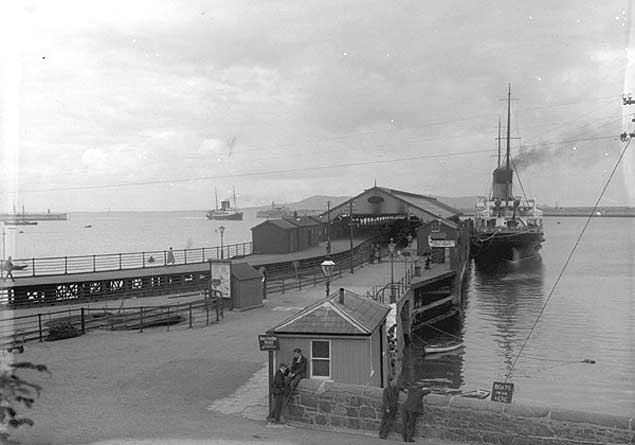 The glory days of Dun Laoghaire as a ferry port, when Victorian engineering ingenuity inserted the Carlisle Pier into the harbour in 1859 as though it had always been there, in order to bring Ireland’s growing railway system into direct contact with the cross-channel ferry service. It was neat and economical of space, with no need for huge car and truck marshalling yards.
The glory days of Dun Laoghaire as a ferry port, when Victorian engineering ingenuity inserted the Carlisle Pier into the harbour in 1859 as though it had always been there, in order to bring Ireland’s growing railway system into direct contact with the cross-channel ferry service. It was neat and economical of space, with no need for huge car and truck marshalling yards.
Cynics may point out that Dun Laoghaire’s years of administrative malfunction roughly coincide with the inauguration of the new Irish state. That’s probably too simplistic, but it is a fact that all efforts to modify the harbour for the accommodation of Ro-Ro ferries have ended with environmental messes which sometimes didn’t even get properly cleared away when their usefulness has ceased.
When Carlisle Pier was irretrievably cut off from the main rail network because rail transport was rapidy declining in the face of road growth while the Dun Laoghaire line itself was becoming a significant part of the new DART commuter system, the pier was gradually reduced in its usefulness. For a while, a now mercifully forgotten Ro-Ro berth was spatch-cocked on to the East Pier just north of the National Yacht Club. In this case, its detritus was cleared away when British rail introduced a new much larger ship which required a real cat’s cradle of ramp facilities right in front of the Royal St George Yacht Club, leading to a ramp attached to the west side of the now-decaying Carlisle Pier.
Then came the advent of the even bigger cross-channel HSS (High Speed Ship). A giant and expensive-to-run object which floated and went fast (you would hardly call it a ship), it provided much entertainment for kids learning sailing in the new Laser class, as they challenged each other to sail under the length of it between the hulls. But whether or not it made money was always a moot point, and it didn’t do to be on the last sailing cross-channel of the day, as they could sometimes run at slow speed to save fuel costs, and you’d invariably arrive late.
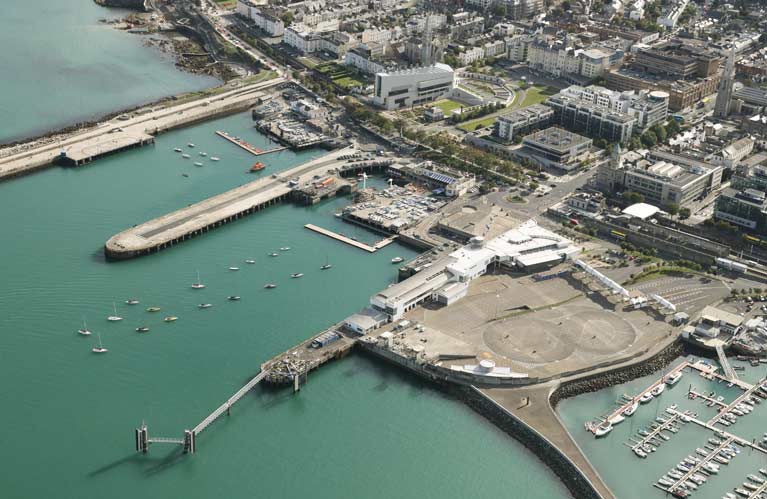 The enormous but unused car marshalling yards and ferry terminal buildings installed at St Michael’s Wharf, with the Royal St George YC and the National YC beyond. At present, it seems that the legal situation regarding the very existence of the St Michael’s Wharf installations may be a matter of debate. Photo Barrow Coakley/Simon Coate
The enormous but unused car marshalling yards and ferry terminal buildings installed at St Michael’s Wharf, with the Royal St George YC and the National YC beyond. At present, it seems that the legal situation regarding the very existence of the St Michael’s Wharf installations may be a matter of debate. Photo Barrow Coakley/Simon Coate
Regardless of that, the Irish authorities had rolled over and collaborated in the building of an enormous terminal complex, complete with huge offices and reception halls and whatever, right in the middle of the Dun Laoghaire waterfront at St Michael’s Wharf, while Carlisle Pier to the southeastward was more or less abandoned.
But, challenged by newer and more nimble ferries operating out of the cost-cutting and rapidly-developing Dublin Port which offered quicker access via the Port Tunnel to the fast-growing Irish motorway system, Dun Laoghaire as a ferryport was commercially doomed. In today’s circumstances, you would need a motorway-standard dual carriageway direct from the St Michael’s Wharf ferry terminal complex to the nearest part of the M50 in order for the Dun Laoghaire route to be successful. It would probably cost as much as the HS2 rail-link looks like costing in England (if the HS2 is ever built), but the Dun Laoghaire Harbour to M50 superlink is definitely a non-starter.
As for the brief flirtation with creating a cruise-liner berth, fortunately that was stopped by community action and an increasing awareness that big cruise liners are a high-pollution snare and a delusion. Most of their passengers don’t bother to go ashore, so the main benefit is only in berthing charges, while the few who do go ashore are on bus tours to the nearest internationally-recognised tourism magnets, with the fees for the buses paid as part of the all-up cruise package back in Minneapolis or Beijing or wherever, so only the bus operators benefit, and not the local traders.
Thus now we have Dun Laoghaire, more popular than ever as a sailing centre of international repute, the lungs of the city for those thousands who are just gasping for a bit of sea air, and an increasingly fashionable place to live on the waterfront as environment-harming commercial transport activity reduces.
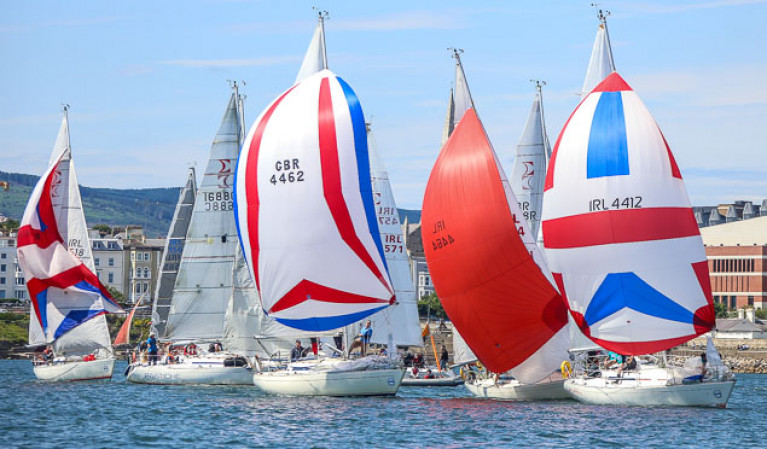 Classic Dun Laoghaire sailing – more popular today than ever. Photo Afloat.ie/David O’Brien
Classic Dun Laoghaire sailing – more popular today than ever. Photo Afloat.ie/David O’Brien
It would seem the most natural thing in the world for town and harbour to move harmoniously together. Yet it is faced with the double problem of how to bring the town behind it up to the level of vitality which the harbour and its waterfront is increasingly manifesting, and how to pay for the maintenance of that harbour which ultimately is the making of the town.
The basic vitality of the harbour manifests itself that despite the fact that, over the years, the authorities officially charged with its administration of it have left behind areas of abandoned dereliction. Looking at the waterfront and its many “units” from seaward provides a clear message which speaks volumes about which sector – public or semi-private - provides the better administration.
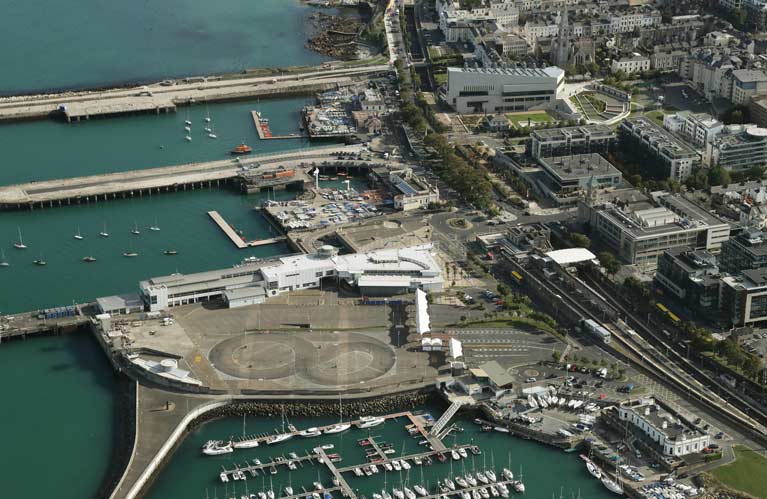 The most visible section of Dun Laoghaire’s waterfront, with the National Yacht Club, the Royal St George Yacht Club, and the Royal Irish Yacht Club very much alive and active, while between them are the “dead” areas of Carlisle Pier and St Michael’s Wharf. Photo: Barrow Coakley/Simon Coate
The most visible section of Dun Laoghaire’s waterfront, with the National Yacht Club, the Royal St George Yacht Club, and the Royal Irish Yacht Club very much alive and active, while between them are the “dead” areas of Carlisle Pier and St Michael’s Wharf. Photo: Barrow Coakley/Simon Coate
The waterfront premises in this category directly interacting with the sea are (going from east to west):
- National Yacht Club: overall voluntary administrators with professional management - very well run.
- RNLI: professionally managed with volunteers – excellent.
- Carlisle Pier: officially managed, a neglected disgrace.
- Royal St George Yacht Club: overall voluntary administraors, professionally managed, very well run.
- St Michael’s Wharf Ferry Terminal: Officially run large unused space with extensive Ferry Terminal Buildings, currently in limbo as official status and existence of Foreshore Licence has not been clarified.
- Dun Laoghaire Marina: Commercial marina with 830 berths, professionally run to an award-winning standard.
- Royal Irish Yacht Club: overall voluntary administrators, professional management, very well run.
- Irish Lights Main Shore Facility and HQ: professionally run National Lights Authority.
- Irish Sailing’s Performance Sailing Base: professionally managed, well run.
- MGM Boats: Boat sales and boatyard services with Travel Hoist: A vital commercial facility which is well run despite being in premises which are limited by the intrusion of some original features of the 200-year-old harbour
- Coal Harbour (aka Inner Harbour): Mainly under official management, limited by presence of features from original harbour and location of under-utilised former Coastguard Building, entire setup too ready to avail of income from car-parking for nearby railway station.
- St Michael’s Rowing Club: Hugely effective voluntary organisation which functions very successfully despite its shoreside premises being in a cave-like space under one of the raised roadways which remain as part of the original harbour.
- Irish National Sailing School: Commercial operation which very effectively introduces hundreds to sailing and boating each year, yet manages to create a club-like atmosphere in rather restricted premises.
- Dun Laoghaire Motor Yacht Club: Friendly voluntarily-run club with some professional input which makes the very best of restricted quayside premises.
 Tough training with one of the coastal rowing skiffs of St Michael’s Rowing Club. Photo: W M Nixon
Tough training with one of the coastal rowing skiffs of St Michael’s Rowing Club. Photo: W M Nixon
That is only a very basic list. There are many workers in the marine industry who manage to function all along Dun Laoghaire currently disjointed waterfront, but who know that it could all be so much better if only the town and harbour had a more cohesive sense of themselves together, and if in turn the waterfront could itself be allowed to function in a more concerted way.
But now that the council finally has control of Dun Laoghaire Harbour, ideas which have been bubbling beneath the surface for some time are beginning to emerge, and with a certain logic it looks as though the first steps will be taken to re-purpose the Carisle Pier, that part of the waterfront which has been the longest neglected.
A specialist group from Irish Sailing and Dun Laoghaire Rathdown Council have been exploring and developing ideas for a National Watersports Campus with a new building on the east side of the inner end of the Carlisle Pier with sea access on the west side. “Access” is the key to it all – the National Watersports Campus would be very much a public facility which would provide a user-friendly route to interaction with boats and Dun Laoghaire Harbour and Dublin Bay and the sea beyond.
 The proposed National Watersports Campus and Municipal Sailing Centre will bring the Carlisle Pier back to life
The proposed National Watersports Campus and Municipal Sailing Centre will bring the Carlisle Pier back to life The location of the proposed Municipal Sailing Centre and National Watersports Campus is at the head of the Carlisle Pier between the Royal St George YC and the National YC
The location of the proposed Municipal Sailing Centre and National Watersports Campus is at the head of the Carlisle Pier between the Royal St George YC and the National YC
Clearly the loss of the car-parking currently provided for want of anything better to do with Carlisle Pier is going to be something of a problem. But it should be said that car-parking is something which deserves much more attention nationally and internationally than it currently receives. They should have university departments specializing in it, for it affects most of us, and taking the easiest options of open space parking now means, for instance, that the USA has enough designated car-parks to cover the entire state of Connecticut. This may seem only tangential to the problems of Dun Laoghaire, but already elsewhere in the harbour the soft option of “making it a car park” has been too readily used.
Anyway, with the new National Watersports Campus brought into being on Carlisle Pier, we move next to St Michaels Wharf and the vast expanses of the former ferryport. It cries out for a built development. If they could only sort out whether or not its very existence is legal in the first place, there’s still enormous potential in the option of developing some of the Terminal Buildings as a growing tech hub, but equally I don’t see why it shouldn’t be seen in terms of residential development.
 An area of enormous potential. By developing all of the St Michael’s Wharf space for residential use and as a tech hub, a significant part of Dun Laoghaire town would in effect be moved into the middle of the harbour, thereby strengthening the links between the two. Photo: Barrow Coakley/Simon Coate
An area of enormous potential. By developing all of the St Michael’s Wharf space for residential use and as a tech hub, a significant part of Dun Laoghaire town would in effect be moved into the middle of the harbour, thereby strengthening the links between the two. Photo: Barrow Coakley/Simon Coate
It wouldn’t be the kind of place where you could comfortably raise a typical Irish family, but it would be ideal for more senior residents who enjoy being beside the sea and in the midst of living activity, yet can no longer be an active part of all of it.
David McWilliam rightly makes the point that developing Dun Laoghaire properly will lead to an interface between the public and private sector, but frankly if the St Michael’s Wharf spaces are going to be attractively developed for some residential use, it will need the inspired input of the private sector, though perhaps under reasonably strict controls.
By making St Michael’s Wharf partly residential, we strengthen the links between town and harbour by literally creating a new part of the town into the middle of the harbour. You would be surprised by how well such new developments can work.
But in taking an overview of possible re-development of the Dun Laoghaire waterfront’s under-utilised spaces, we should remember that one of the shop-keepers to whom Jennifer O’Connell talked spoke of the need to make Dun Laoghaire a tourist magnet “like Howth”.
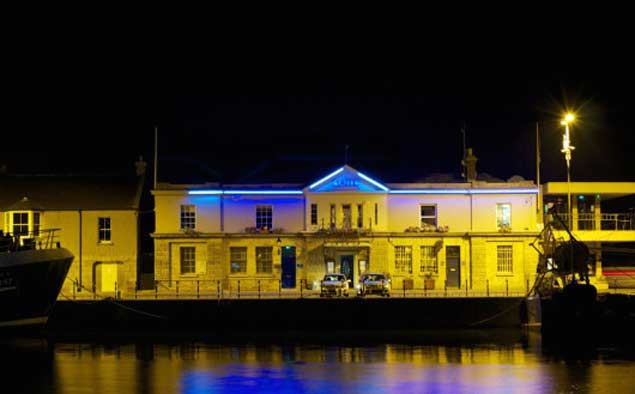 Just three of the unplanned mix of buildings on the West Pier in Howth include (left to right) the former Customs House (it may be needed again with Brexit), the Harbour Masters Office, and Aqua Restaurant in the former Howth Yacht Club building
Just three of the unplanned mix of buildings on the West Pier in Howth include (left to right) the former Customs House (it may be needed again with Brexit), the Harbour Masters Office, and Aqua Restaurant in the former Howth Yacht Club building
You should be careful what you wish for, Madam. Howth is sometimes over-run. Nevertheless, all the Dun Laoghaire waterfront developments we’ve referred to thus far will be carefully-planned and inevitably modern-looking buildings. In contrast, the quaint charm of Howth’s West Pier with its many restaurants, fish shop and whatever is that it was not planned in any way at all. In fact, once the modern harbour had emerged in its current shape in the mid-1980s, the OPW – the Office of Public Works - saw itself still as the OPW, but this time it was as the Office of Public Wrecking.
They wanted to knock every bockety little building along the West Pier in order to create more room for fish lorries and other industrial traffic, and the plan was to move any still existing highly-individualistic little businesses into a nearby and ever so modern Business Park.
Fortunately, official inertia and probably a convenient national financial crisis prevented anything further happening in the destruction department, and after the empty buildings had remained so for some time, private enterprise finally got its way and took them over for the present cheerful visitor-attracting selection of retail outlets of all kinds.
It all happened by happy accident. But you can’t plan happy accidents. Nevertheless I would suggest that as the east end pf the Dun Laoghaire Harbour waterfront right along as far westward as the Irish Lights premises is going to be under a formalized look, as a bit of welcome contrast we should take a radical overview of the entire Inner Harbour – the Coal Harbour area if you prefer – to see how it could be allowed to become a characterful Dun Laoghaire version of the vieux port which you’ll find in any half decent French harbour of character.
There’s far more space down towards the Coal Harbour than you’d think – it only seems limited because that great big ramp road down to Trader’s Wharf or whatever it’s called cuts the area in two. Immediately east of the ramp, there’s the old coastguard station, which is surely ripe for multiple craft and character uses and could be the centre of a new/old harbourside village if only that big ramp thing could be done away with altogether, for there are already two other ways of accessing the inner harbour.
 The hidden site with potential for the Old Dunleary Harbour Village. At present divided by the large ramp road - half of which is used for parking - the area between Irish Lights and the Coal Harbour includes the old Coastguard Station which could be the central focus for a characterful small-scale development. Photo: Barrow Coakley/Simon Coate
The hidden site with potential for the Old Dunleary Harbour Village. At present divided by the large ramp road - half of which is used for parking - the area between Irish Lights and the Coal Harbour includes the old Coastguard Station which could be the central focus for a characterful small-scale development. Photo: Barrow Coakley/Simon Coate
The potential is enormous. But in the first instance, Dun Laoghaire town has to get its act together regarding the changeover from retail to residential, for the narrow streets in the heart of the old town are really only capable of supporting about a third of the shop premises – many already boarded up – which give the place such a sad air.
So the “old town” becomes much more residential, but with a growth in the proportion of service-providing retail outlets, while new life is given to the waterfront with the National Watersports Campus on the Carlisle Pier and an impressive residential and tech hub on the St Michael’s Wharf site.
Along to the west we’ll have the new yet characterful Old Dunleary Harbour Village gathered around the old Coastguard Building, a place with a variety of eating places including some so new and trendy that they’ll be discovered for the rest of the world by the Restaurant Critic of The Irish Times, and so the Paper of Record can make friends again with people who actually live and work in the Dun Laoghaire waterfront area.
































































